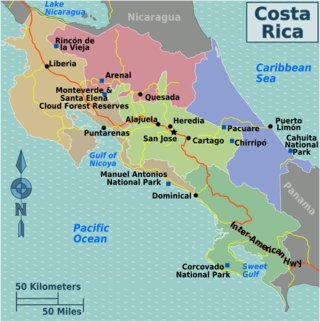
The illegal drug trade, drug trafficking, or narcotrafficking is a global black market dedicated to the cultivation, manufacture, distribution and sale of prohibited drugs. Most jurisdictions prohibit trade, except under license, of many types of drugs through the use of drug prohibition laws. The think tank Global Financial Integrity's Transnational Crime and the Developing World report estimates the size of the global illicit drug market between US$426 and US$652 billion in 2014 alone. With a world GDP of US$78 trillion in the same year, the illegal drug trade may be estimated as nearly 1% of total global trade. Consumption of illegal drugs is widespread globally, and it remains very difficult for local authorities to reduce the rates of drug consumption.

The United Nations Office on Drugs and Crime is a United Nations office that was established in 1997 as the Office for Drug Control and Crime Prevention by combining the United Nations International Drug Control Program (UNDCP) and the Crime Prevention and Criminal Justice Division in the United Nations Office at Vienna, adopting the current name in 2002.

Antonio Maria Costa is an Italian economist. He lives in Vienna and Brussels.

Crime is one of the most urgent concerns facing Mexico, as Mexican drug trafficking rings play a major role in the flow of cocaine, methamphetamine, fentanyl, heroin, and marijuana transiting between Latin America and the United States. Drug trafficking has led to corruption, which has had a deleterious effect on Mexico's Federal Representative Republic. Drug trafficking and organized crime have been a major source of violent crime. Drug cartels and gangs have also branched out to conduct alternative illegal activities for profit, including sex trafficking in Mexico. Some of the most increasingly violent states in Mexico in 2020 included Guanajuato, Zacatecas, Michoacán, Jalisco, and Querétaro. Some of the world's most violent cities are reportedly within the state of Guanajuato with extortion from criminal groups now being commonplace. The state of Zacatecas is said to be valuable to multiple organized crime groups for drug trafficking, specifically methamphetamine to the United States. As of 2021, Michoacán is experiencing increased instances of extortion and kidnapping due to a growing presence and escalation in the armed conflicts between CJNG and Cárteles Unidos on regions bordering the neighboring state of Jalisco. CJNG is also currently battling the Los Chapitos faction of the Sinaloa Cartel in the North Mexican region of Sonora.

Transnational organized crime (TOC) is organized crime coordinated across national borders, involving groups or markets of individuals working in more than one country to plan and execute illegal business ventures. In order to achieve their goals, these criminal groups use systematic violence and corruption. Common transnational organized crimes include conveying drugs, conveying arms, trafficking for sex, toxic waste disposal, materials theft and poaching.
Prostitution in Costa Rica is legal. Costa Rica's legal system is based on Roman law rather than common law, and so for prostitution to be illegal it would have to be explicitly stated as such in a penal code, and it is not. Nevertheless, many of the activities surrounding it are illegal, as the law forbids promoting or facilitating the prostitution of another, and therefore pimping, brothels, or prostitution rings are illegal. Prostitution is common and is practiced openly throughout the country, particularly in popular tourism destinations.

Crime in Brazil involves an elevated incidence of violent and non-violent crimes. Brazil's homicide rate was 27.4 per 100,000 inhabitants, according to the United Nations Office on Drugs and Crime (UNODC). Brazil has the highest number of intentional homicides in the world, with 57,358 in 2018. In recent years, the homicide rate in Brazil has begun to decline. The homicide rate was 20.64 per 100,000 in 2020 with 43,879 killings, similar to 2019, but down from 30.67 per 100,000 in 2017.

Crime in Russia refers to the multivalent issues of organized crime, extensive political and police corruption, and all aspects of criminality at play in Russia. Violent crime in Siberia is much more apparent than in Western Russia.

Crime and violence affect the lives of millions of people in Latin America. Some consider social inequality to be a major contributing factor to levels of violence in Latin America, where the state fails to prevent crime and organized crime takes over State control in areas where the State is unable to assist the society such as in impoverished communities. In the years following the transitions from authoritarianism to democracy, crime and violence have become major problems in Latin America. The region experienced more than 2.5 million murders between 2000 and 2017. Several studies indicated the existence of an epidemic in the region; the Pan American Health Organization called violence in Latin America "the social pandemic of the 20th century." Apart from the direct human cost, the rise in crime and violence has imposed significant social costs and has made much more difficult the processes of economic and social development, democratic consolidation and regional integration in the Americas.
Crime in Honduras has become a growing matter of concern for the Honduran population in recent years. Honduras has experienced alarmingly high levels of violence and criminal activity, with homicide rates reaching a peak in 2012, averaging 20 homicides per day. Corruption, extortion, coercion, and drug smuggling also run rampant throughout Honduran society, preventing the nation from building trustworthy authorities like police, and severely limiting economic, social, or political progress. The situation has prompted international organizations and governments to offer assistance in combating crime in Honduras.
Rates of crime in Guatemala are very high. An average of 101 murders per week were reported in 2018. The countries with the highest crime and violence rates in Central America are El Salvador and Honduras. In the 1990s Guatemala had four cities feature in Latin America's top ten cities by murder rate: Escuintla, Izabal (127), Santa Rosa Cuilapa (111) and Guatemala City (101). According to New Yorker magazine, in 2009, "fewer civilians were reported killed in the war zone of Iraq than were shot, stabbed, or beaten to death in Guatemala," and 97% of homicides "remain unsolved." Much of the violent nature of Guatemalan society stems back to a 36-year-long civil war However, not only has violence maintained its presence in the post-war context of the country following the Guatemalan Civil War, but it has extended to broader social and economic forms of violence.

Slovakia is a Central European country with a history of relatively low crime. While crime became more widespread after the Revolutions of 1989, it remains low when compared to many other post-communist countries.
Human trafficking is an act of recruiting, transporting, and harboring people against their will; usually by using force. People who are trafficked are mostly used for sexual purposes or illegal work. These acts include: forced marriages, trafficking for human organs, and gaining members for organized crimes. Every country in the world deals with this crime, and are usually classified as transit countries, target countries, or source countries. Guatemala is a part of North America, which is a target country; this means they contain human trafficking victims.

Costa Rica is a source, transit, and destination country for goods and products, a great location for trade in the seas. Costa Rica is surrounded by the Pacific Ocean and the Caribbean Sea making it a source of imports and exports. Costa Rica is approximately 19,653 square miles of land, making it smaller than West Virginia. To a lesser but increasing extent, Costa Rica is a source, transit, and destination country for men, women, and children subjected to conditions of forced labor, particularly in the agriculture, construction, fishing, and domestic service sectors. The economy greatly depends on the exportation of bananas and coffee, making high demands of agriculture work. Costa Rican women and children are forced into commercial sexual exploitation due to high rates of poverty and violence. Women and girls from Nicaragua, the Dominican Republic, Guatemala, Colombia, and Panama have been identified in as victims of forced prostitution. Child sex tourism is a serious problem, particularly in the provinces of Guanacaste, Limón, Puntarenas, and San José. Child sex tourists arrive mostly from the United States and Europe. Young men from Nicaragua, Vietnam, China and other Asian countries are subjected to conditions of forced labor in Costa Rica. Adults have been identified using trafficked women and children to transport and sell drugs. Neighboring countries and cities are victims as well to forced labor many times trafficked to Costa Rica.

Though the Cuban government does not release official crime statistics, Cuba is considered one of the safer countries in Latin America. Gun crime is virtually nonexistent, drug trafficking has been largely curtailed, and there is below-average crisis intervention from police. Murder rates are also below those of most Latin American countries, with an intentional homicide rate of 5.00/100,000 inhabitants in 2016, lower than any other country in the region.

Sustainable Development Goal 16 is one of the 17 Sustainable Development Goals established by the United Nations in 2015, the official wording is: "Promote peaceful and inclusive societies for sustainable development, provide access to justice for all and build effective, accountable and inclusive institutions at all levels". The Goal has 12 targets and 23 indicators.
Maritime drug smuggling into Australia refers to the smuggling of illicit drugs into Australia by sea. While much contemporary Australian media coverage has focused on smaller, more personalised smuggling cases such as the Bali Nine, maritime drug smuggling often allows criminal groups to move illicit drugs and substances into Australia at a much greater scale. This has happened through a variety of ways, including via cargo ship, yacht, and fishing vessels. Key departure locations for drugs aimed to be smuggled into Australia include China, India, Southeast Asia, and the Americas, with much of the drugs trafficked via countries and territories in the South Pacific, in close proximity to Australia.
Maritime cocaine smuggling refers to the practice which involves the smuggling of cocaine between borders via maritime means. According to the United Nations Office on Drugs and Crime (UNODC), there are an estimated 18 million users of cocaine globally. Approximately 70-80% of cocaine is at some point smuggled across the ocean, originating from South America. Cocaine remains the "highest value criminal commodity for transnational organised crime", motivating the criminal organisations responsible for maritime smuggling practices. Maritime cocaine smuggling is therefore an ongoing international issue, as criminal organisations are finding new and innovative ways of smuggling cocaine and go undetected by authorities.
Over time, there has been an increase in sex trafficking in Central America. Because of the lack of financials, work opportunities and studies, women and men see sex work as the solution to their problems. In addition, the living conditions, poverty, and gang violence are the reason as to why a lot of people have been coerced into sex trafficking. These countries are working with their government and other countries in order to create laws to fight against sex trafficking.












